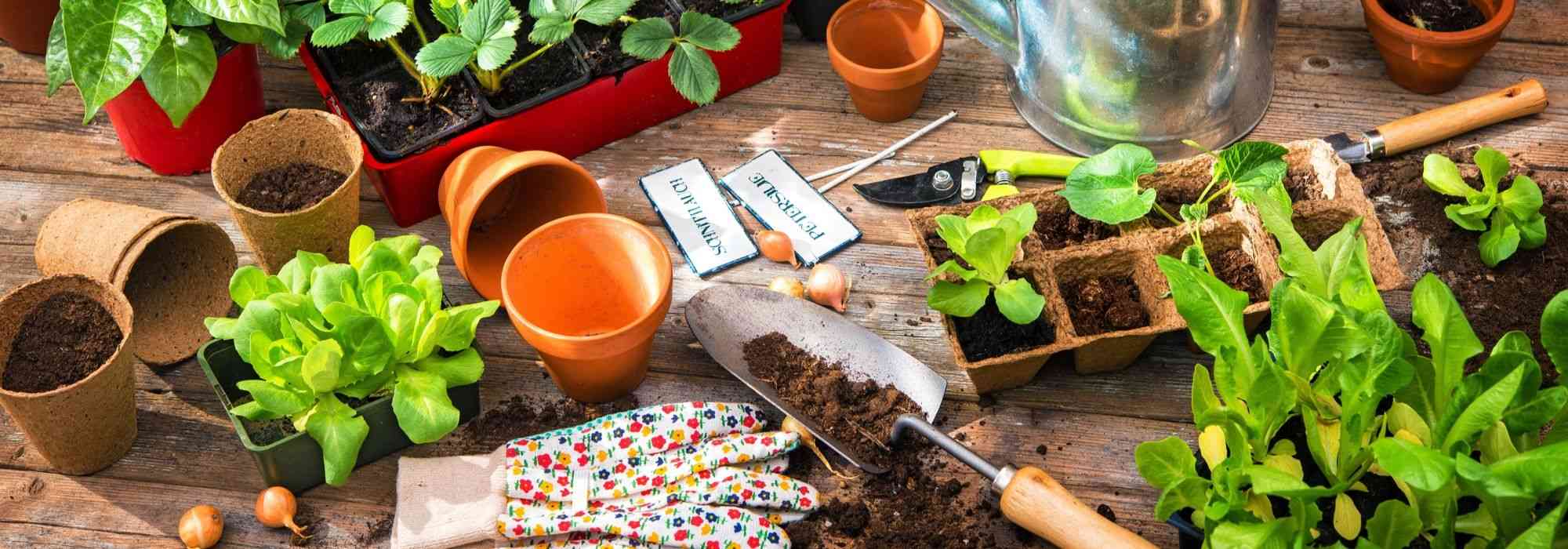
5 ways to get plants for free
Sowing, propagation by cuttings, layering, clump division, grafting: how to choose? Explanations, advantages and disadvantages
Contents
Plants multiply much more easily than you might imagine and there are many easy techniques to obtain plants for free to landscape and flower your garden.
Some of these techniques, such as propagation by cuttings, layering and suckering, allow you to produce identical plants; they are grouped under the term vegetative propagation. Sowing, however, generally does not preserve exact characters of the selected variety but often yields pleasant surprises!
Here are, in detail, 5 techniques that will allow you to multiply your plants (trees, bushes, perennials, annuals…) easily and at little cost.
Sowing
Principle
Propagating plants by sowing consists of collecting seeds from flowers or fruits to sow. Seeds can be sown immediately or dried and stored in a dry, dark place so they can be kept for a few months to several years.
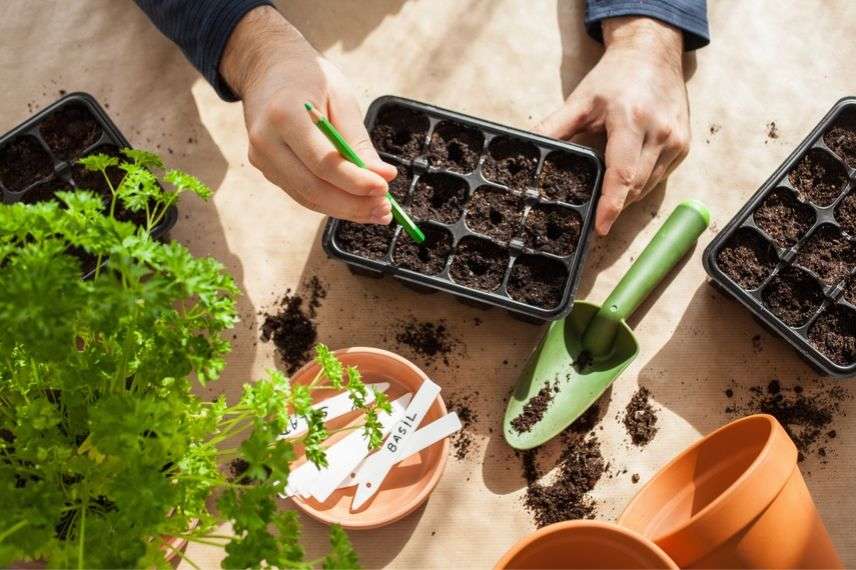
Difficulty level
Sowing seeds is generally easy. Nevertheless, bear in mind that some seeds such as those of acacias or Proteaceae are very hard and sometimes need passage through fire to be released from the fruit and then to germinate, softening of their cuticle by microbes in a wet medium, or passage through an animal’s intestine. Other seeds need cold stimulation to wake up and germinate… Finally, conditions for seed germination can be delicate to create: humidity, temperature… and some require patience because germination can take from a few days to several months.
Advantages and disadvantages
• This method of propagation is very inexpensive, since one plant can produce thousands of seeds in a season.
• Seed storage takes up little space and can last several years, but note that a seed’s germination longevity varies greatly depending on species and storage conditions.
• A plant produced by sowing may show some differences compared with the parent plant that produced it. Differences are sometimes invisible and beneficial, such as resistance to a parasite or better adaptation to dry or wet soil. Sometimes differences are very visible, such as flower colour or size. Volunteer seedlings of horticultural asters or squash rarely give the same plant, for example.
• A tree grown from a seed will take more years to reach ripeness, that is to flower and fruit, than an individual produced by propagation by cuttings or grafting, but its establishment in the soil will be better because of a taproot arising from the radicle that penetrates very deeply into the soil, and its lifespan will be longer than that of a plant from a cutting or graft.
Main plants suited to the technique
• annuals such as cosmos, sunflowers, love-in-a-mist (Nigella damascena)
• biennials, or those grown as such, like forget-me-nots, primroses and begonias
• perennial plants such as columbines, rudbeckias, lupins
• certain trees and bushes such as albizia, beech, maple, ginkgo
• vegetable and aromatic plants such as tomatoes, beans, beetroot, dill…
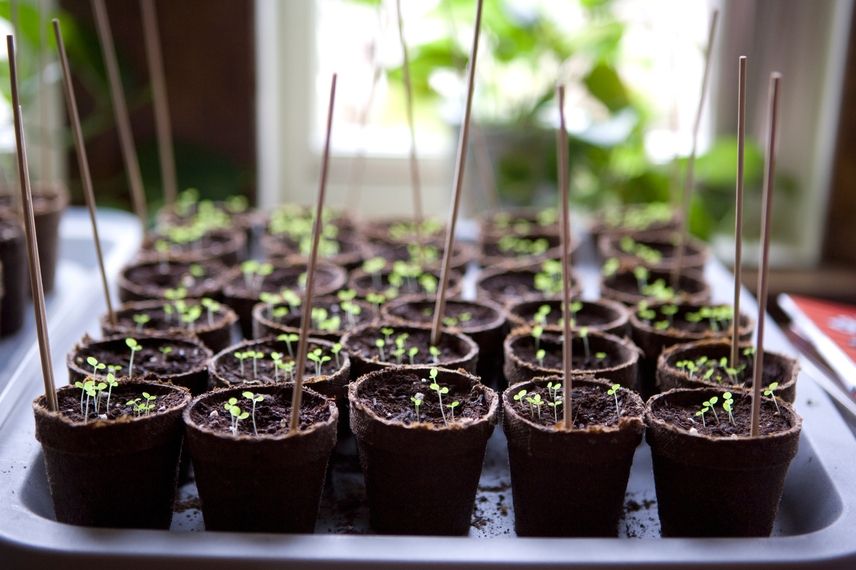
Warm sowing
Did you know?
What defines a species or “type species”, and even a subspecies such as Prunus lusitanica ssp. azorica, corresponds to a wild form described as a “pure race” that generally retains its characters when it reseeds itself, that is when it carries out sexual reproduction via its flowers transformed into fruits and seeds. This mode of reproduction ultimately allows the plant to evolve very slowly and to adapt, through chance and natural selection, to new conditions.
To find out more
Read these articles :
- Saving seeds: harvest and store them
- Sowing seeds: everything you need to know
- 10 very easy perennials to sow
Read also
15 very easy plants to propagatePropagation by cuttings
Principle
Multiplying plants by propagation by cuttings involves taking a piece of the plant (stems, leaves, roots, bulblets) and encouraging it to root in favourable conditions. Plants have this advantage over animals of being able to reconstitute a complete individual from a fragment of plant tissue (except the flower). Take advantage of this to increase number of your plants for free!
Level of difficulty
Rooting a section of stem in a glass of water shows how propagation by cuttings can be child’s play. However, success varies depending on the plant: succulents (Kalanchoe, Sedum), willow, hydrangea, oleander, botanical roses… root very easily, unlike camellias and rhododendrons. Success of a cutting also depends on season, temperature, humidity level and the organ taken (stem, leaf, root).
Advantages and disadvantages
- For the amateur gardener seeking to obtain a few plants, a single mother plant (young plant from which you take cuttings) may suffice, but a nurseryman sometimes needs to grow many mother plants to obtain a sufficient number of cuttings.
- Cuttings keep for only a short time, a few days in a cool place, wrapped in a damp cloth or in a glass of water.
- Growing cuttings can be tricky in some cases and require close attention to watering, temperature and ventilation to avoid rot. However . Sparsely branched plants or plants with hard wood are better multiplied by air layering (see below).
- If the mother plant carries a virus, a fungus or a bacterium, young plants obtained are very likely to be infected. In this regard, in horticulture in vitro culture has revolutionised things by making it possible to obtain new plants guaranteed free from disease by culturing a few cells contained in buds. Number of plants obtained is also much greater than with stem cuttings but it is reserved for professionals because it requires a laboratory and a delicate weaning period to transfer the plant from its test tube filled with gel to a pot filled with soil!
- Longevity of a tree grown from a cutting is shorter than that of one originating from sowing; its vigour and resistance to drought are often lower.
- Its ripeness is reached more quickly.
Main plants suited to the technique
Most plants grown for ornament are cultivars that are multiplied by stem cuttings. These are mainly:
- perennial plants (houseplants and others),
- bushes (old or landscape rose bushes, hydrangea, forsythia…) also because of their high added value compared with forest or market-garden seedlings.
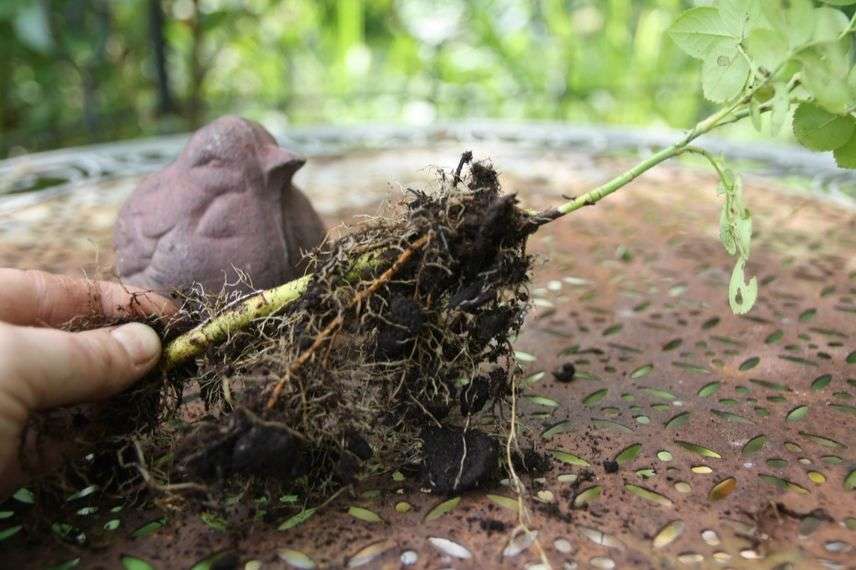
Rooted rose cutting
Did you know?
Natural cloning can sometimes prolong life of a tree over millions of years, as with quaking aspen (Populus tremuloides) in western United States (Utah), which forms a colony of 40,000 trunks covering 44 ha and is estimated to be 80,000 years old!
To learn more
Feel free to consult these articles :
Clump division and related techniques
Principle
Division consists of splitting a clump of perennials, grass or bushes into several pieces each bearing roots. Some plants make this type of propagation easier by producing detachable organs such as strawberry stolons, suckers of Kolkwitzia or false acacia that are separated or detached and put to root in soil.
Level of difficulty
Dividing a plant requires some physical effort and should be practised in autumn or spring to reduce transplantation stress. Know that it is often more practical to dig up entire stump when not too large.
Advantages and disadvantages
- As with propagation by cuttings, if plant is infected, resulting shoots will also be infected.
- Mother plant undergoes stress from transplantation and loses part of its original volume.
- Number of new specimens is quite limited but they are much more vigorous and less fragile than a young cutting.
Main plants suitable for this technique
Division of clumps is practised:
- with perennials in general such as asters, garden irises,
- with certain bushes such as Kolkwitzia, lilac (ungrafted), Aralia elata…
Trees are generally excluded from this propagation method unless they produce suckers, such as poplar.
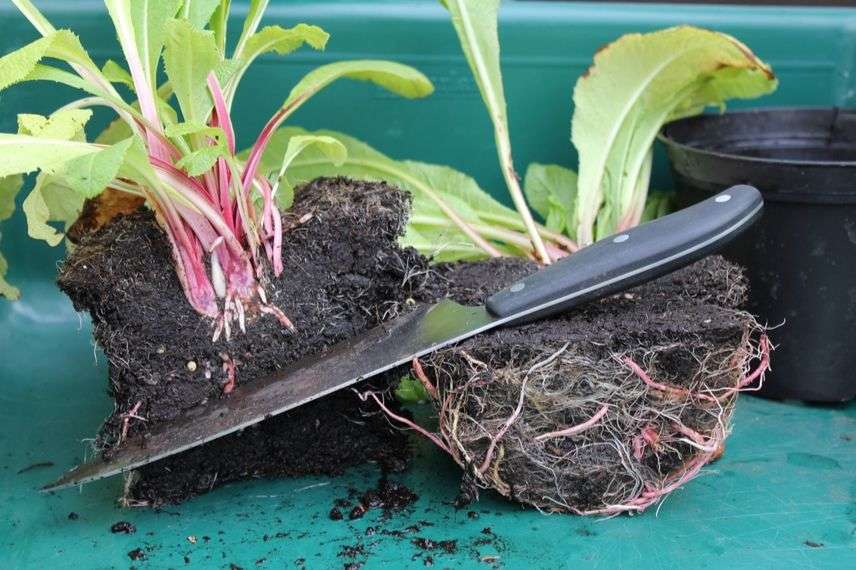
Division of a primrose clump
To find out more
Some articles dealing with division:
- Dividing a grass (video)
- How to divide and multiply your bamboos
Read also
How to take lilac cuttings?Layering
Principle
Layering consists of inducing formation of roots on a portion of an aerial stem that is buried or confined using damp moss wrapped in plastic sheeting. The layer remains attached to the parent plant for the time required for root production.
Difficulty level
Layering is an easy technique, climbing plants propagate well this way because their long flexible stems can easily be buried near the parent plant. This technique is used when propagation by cuttings is difficult or when one has time and wants to obtain a second specimen without too much fuss.
Advantages and disadvantages
- The method requires several months (6 to 12 months) but the success rate is very high.
- Number of young plants obtained is limited.
- Traditional layering has the advantage of being carried out outdoors without equipment, directly in open ground or in a buried pot.
- Care is minimal: risk of rot encountered in propagation by cuttings is absent; watering does not require special attention.
- Finally, the parent plant is not damaged by removal of shoots as with propagation by cuttings.
Main plants suitable for this technique
- Climbing plants such as honeysuckles, clematis, wisteria and sarmentous roses,
- Spring-flowering bushes such as forsythia and viburnum; hydrangea is also suitable for layering in ground.
- For Rhododendron, Magnolia, Hamamelis, Edgeworthia chrysantha, handkerchief tree, Hibiscus, rubber plant, air layering is easier to perform than propagation by cuttings.
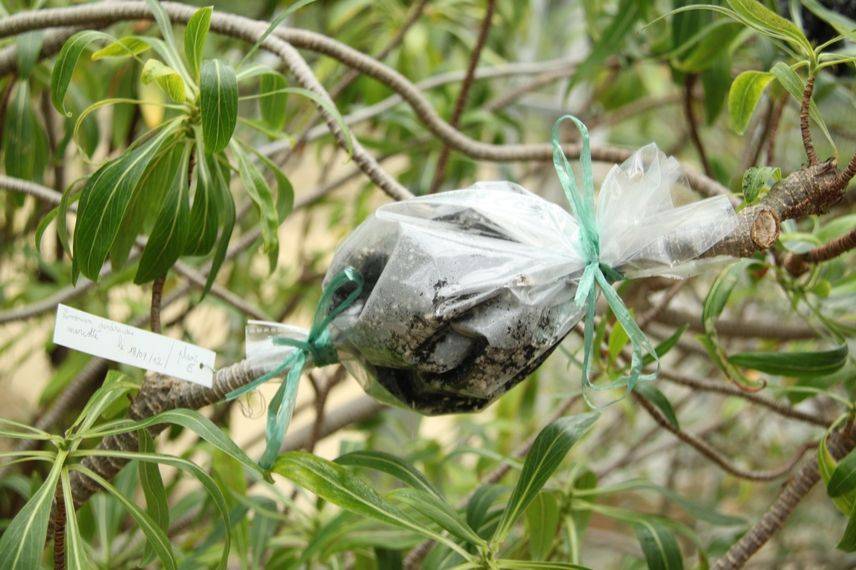
Air layering
Find out more
Discover our advice sheet: “Layering: how to do it?
Graft
Principle
Grafting consists of attaching a shoot or just a bud (shield graft) of the desired variety to a young seedling from sowing, or to an established fruit tree when one wants to change the variety or renew the branches. Grafting techniques are varied: cleft graft, crown graft, shield graft with a growing eye or dormant eye, the complicated English graft, bark graft, approach graft, machine omega graft…
Difficulty level
Grafting is a fairly difficult technique to succeed because the rootstock must be vigorous, compatible with the scion and the tissues must be well aligned so they can fuse. Many years of experimentation are often necessary to master this technique.
Advantages and disadvantages
- Grafting makes it easier to grow any variety in soils that can be unsuitable – calcareous, wet, dry – provided the rootstock is chosen carefully.
- The variety often reaches maturity more quickly than from sowing.
- Tree vigour can be modified by the type of rootstock, which allows production of dwarf, low- or medium-vigour young plants, easier to integrate into our gardens.
- Grafting is also used to produce different habits, for example a sarmentous rose grafted onto a rigid rose to obtain a standard rose.
- The graft union, often swollen, remains a weak area that can favour entry of parasitic organisms.
- Grafted trees generally live for a shorter time than trees grown from seed.
Main plants concerned by the technique
- Fruit trees,
- certain cultivars of ornamental trees such as mulberry, weeping trees, standard roses…
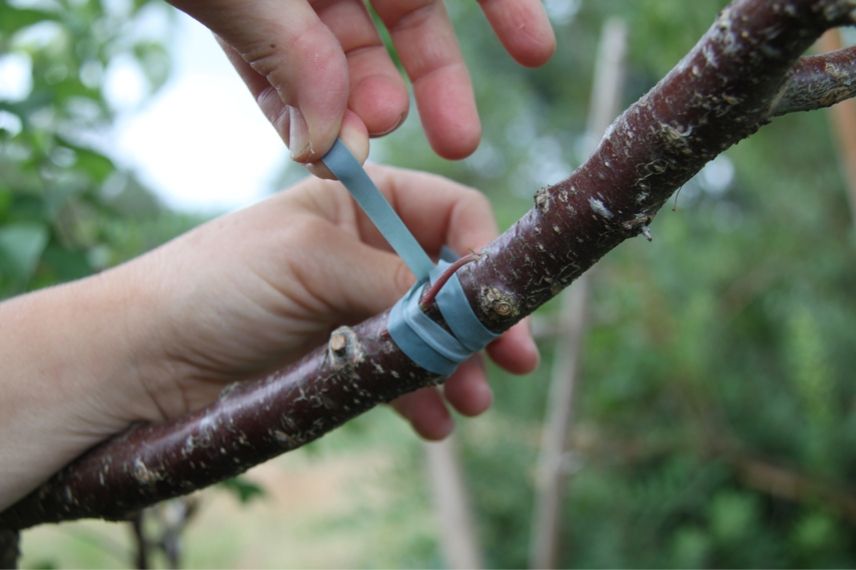
Grafting being carried out on an apricot tree
Are you allowed to propagate all plants?
Yes and no!
New plant varieties that have obtained a plant variety certificate (COV) after an application to Committee for the Protection of Plant Varieties, are protected by law for a period of 25 to 30 years. COV is a kind of patent dedicated solely to plant varieties. Since 2006, it has also been possible in France to protect a variety by filing a patent, as for inventions, valid for 20 years.
This certification guarantees novelty, homogeneity and stability of this new cultivar and requires nursery grower to pay a royalty to breeder if they wish to reproduce plant for commercial purposes. However private individual retains right to propagate a few plants in a private setting, for their own use or to give to family or friends provided this is not commercial. Protected variety may also be used freely to obtain a new variety or for research.
You can easily tell whether plant is protected by reading full name: this certificate leads to registration of a trademark shown in CAPITAL LETTERS followed by an R in a circle or COV in superscript. Official name of plant therefore consists of a genus name possibly followed by species name both in italics, followed by trademark name and, in quotation marks, a cultivar name which is generally less used than trademark: Rosa ASTRONOMIA ® ‘Meiguimov’ is most often referred to as Rosa ASTRONOMIA
You can therefore indulge in vegetative propagation or sowing of plants from your gardens without having to pay royalties! It is free even though it sometimes requires a little patience, technical skill and equipment (cold frame, propagation trays, clean potting compost…).
- Subscribe!
- Contents
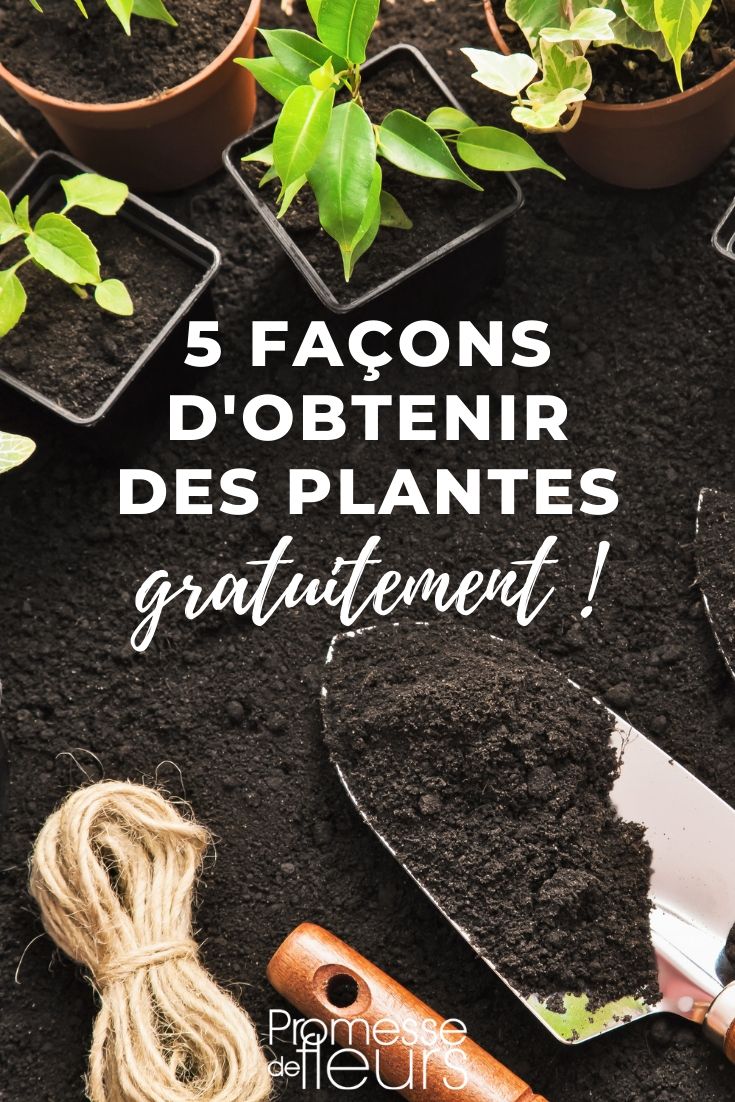































Comments